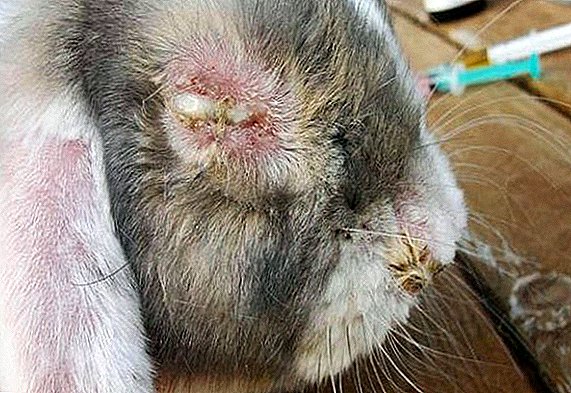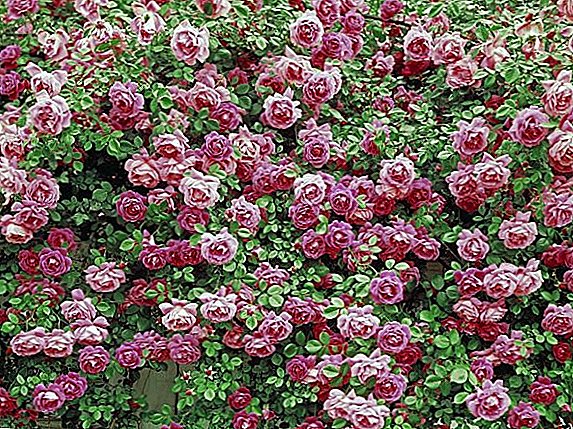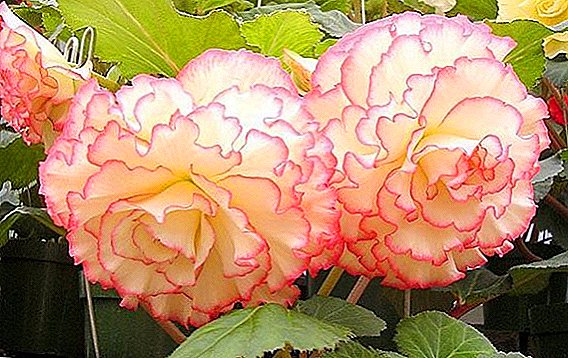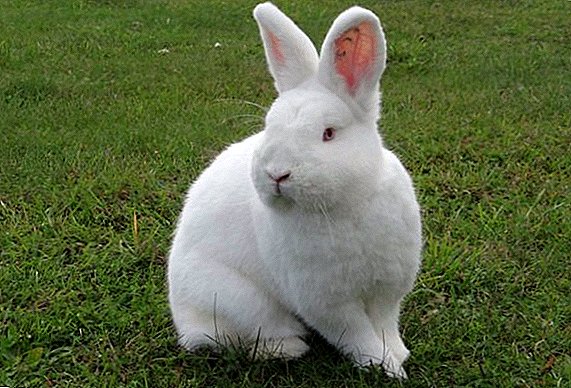 The New Zealand white rabbit (NZB) is considered one of the most common eared representatives of this species on the ground. Its history began more than a hundred years ago, and today it continues to conquer the hearts of breeders with its characteristics and unpretentious care. Below we describe what is known about this breed, as well as how to maintain, care for and breed these Fuzzies.
The New Zealand white rabbit (NZB) is considered one of the most common eared representatives of this species on the ground. Its history began more than a hundred years ago, and today it continues to conquer the hearts of breeders with its characteristics and unpretentious care. Below we describe what is known about this breed, as well as how to maintain, care for and breed these Fuzzies.
Description and history of the breed
The New Zealand breed is a model of productivity among industrial types of rabbits, since they are bred:
- for skins;
- for meat;
- as show animals;
- and, unfortunately, they are used in laboratory studies.
Did you know? The New Zealand white rabbit is considered the fastest growing rabbit in the world: an 8-week-old baby can weigh up to 2 kilograms.
Inference history
Although the species is called New Zealand, it is not tied to geography: it was bred in the USA, in California in 1916, where it received its official registration. Initially representatives of the breed were red rabbits, obtained as a result of breeding silver rabbit Champagne and the Belgian giant.  A little later, albinos were selected from the litters to isolate the breed of New Zealand white rabbits. The first representatives of the white species came to Europe in the 1920s, where they successfully gained recognition from the rabbit breeders.
A little later, albinos were selected from the litters to isolate the breed of New Zealand white rabbits. The first representatives of the white species came to Europe in the 1920s, where they successfully gained recognition from the rabbit breeders.
Important! In rabbits, teeth grow throughout their life, therefore, in order to satisfy the natural need for grinding teeth, thick rounded pieces of wood or salt stone can be placed in the cells.
Appearance and physique
The NZB rabbit is distinguished by the following external characteristics that meet fixed breed standards:
- small head;
- short muzzle with a hook-nosed and wide profile;
- correct bite;
- red eyes, as befits an albino;
- the cylindrical form of the body with well-developed, knocked-out muscles;
- body length: in males - 47.5 cm, in females - 49.5 cm;
- in females, the presence of a symmetric shaped dextye is permissible;
- small upright ears 10 cm long;
- wide breasts;
- straight and short back, turning into a large sacrum and rounded croup;
- strong and erect paws with white claws;
- uniform snow white color;
- shiny, silky and dense fur with short nap;
- dark edging on the muzzle, the tips of the ears, paws and tail is permissible;
- the live weight of an adult individual is from 4 to 5 kg.

Performance Indicators
White New Zealanders have very good weight gain due to the abundant milkiness of females and high-fat milk.
We recommend that you familiarize yourself with the description and characteristics of the content of such meat-skinned rabbit breeds as Ober, Russian Ermine, Gray Giant, Silver, Risen Gold, Poltava Silver, Rex, Belgian Giant and Viennese Blue.
The growth rates of the average live weight of young stock monthly, divided into classes, are:
| Class | 2 months / kg | 3 months / kg | 4 months / kg | 5 months / kg | 6 months / kg | 7 months / kg |
| Elite | 1,8-1,9 | 2,6-2,7 | 3,3 | 3,8 | 4,0-4,1 | 4,5-4,6 |
| I | 1,5-1,6 | 2,4 | 2,8 | 3,3 | 3,5 | 3,8 |
| II | 1,5 | 2,1 | 2,6 | 2,8-2,9 | 3,1 | 3,5 |
| III | 1,2-1,3 | 1,9 | 2,0 | 2,4 | 3,3 | 2,5-2,6 |
The average increase in the length of the body rabbit New Zealanders by month:
- 1 month - 0.6 cm;
- 2 months - 1.6 cm;
- 3 months - 2.5 cm;
- 4 months - 3.2 cm;
- 5 months - 3.5 cm;
- 6 months - 3.8 cm;
- 7 months - 4.1 cm;
- 8 months - 4.3 cm;
- 9 months - 4.5 cm
 Also, rabbits have good rates of early slaughter age, growth of meat and okrol:
Also, rabbits have good rates of early slaughter age, growth of meat and okrol:- thanks to the active growth and good weight gain, they can be scored from 4-6 months;
- a rabbit carcass during this period can weigh 3.5–5 kg;
- the rabbit is distinguished by good fertility and is ready to mate at 5 months of age;
- one okrol brings 8-10 kids;
- for the year the female leads up to 35 rabbits.
Find out what to do if a rabbit has become fat, what urine a rabbit should have, how many rabbits weigh and what to give them for weight gain, is it possible to lift them by the ears, how long the rabbits live and how to determine the age correctly.
Character
White fluffies have a friendly and balanced character, they are not shy and resistant to sudden movements and unexpected loud sounds. Thanks to their calm temper, they can be kept with other pets.
Advantages and disadvantages
The main advantages of the form can be considered:
- high fecundity;
- effective growth of baby rabbits;
- good weight gain;
- excellent slaughter yield;
- calm temper;
- stress resistance.

Disadvantages are the following indicators:
- flabbiness of the skin;
- abundant fat layer on the shoulders;
- demanding on the quality of feed;
- the need for year-round content in closed cells;
- do not tolerate high temperatures.
Maintenance and care
Special difficulties in the maintenance and care of rabbits NZB not bring, if you follow all the necessary recommendations, which will be discussed further.
Did you know? In Europe, the most popular pets are cats, dogs and rabbits.
Selection and arrangement of cells
Best eared brethren feels in mesh cells.  Here are some requirements for their improvement:
Here are some requirements for their improvement:
- the cages must be spacious so that the rabbits can move freely;
- in the cells, you can do without the litter, since the soles of the paws of the New Zealanders are completely covered with wool, which allows them to adapt to the mesh floor;
- if a litter is provided in the cages, then dry hay can be used for this purpose;
- cells can be placed on several floors (no more than three), arranging in them drinkers and feeders;
- In one cage can contain several individuals of the same age, depending on their size.
Familiarize yourself with the features of breeding and keeping rabbits in the shed, pit and aviary.
Conditions of detention
There are certain requirements for the conditions of keeping rabbit NZB:
- in places where there are cages, the temperature should be maintained at 18-24 degrees, higher showed disastrous for pets;
- in a room with rabbits there should not be high humidity;
- be sure to provide good ventilation without the presence of a draft;
- it is impossible for the cages with rabbits to fall into direct sunlight, otherwise it is fraught with heat stroke for pets.

Care and hygiene
In order for New Zealanders to look good and not hurt, certain conditions must be met:
- Indoors, it is necessary to carry out regular cleaning, removing waste products and used litter, which will help keep the rabbit's fur clean and have a positive effect on the taste of meat.
- Regularly clean the feeders from food debris.
- Keep clean the drinkers and fill them daily with clean water.
- Twice a year (autumn and spring), disinfect the cells in order to prevent viral diseases and the spread of pathogens.
- Disinfect the auxiliary equipment: wooden - with hot water, soda and soap, and keep the buckets and plastic feeders for 30 minutes. in a solution of soda ash.
It will be helpful for you to read about whether the rabbit needs litter in the cage, as well as how to disinfect the cage.
Vaccinations
The following vaccinations are mandatory for NZB rabbits, which should be purchased only in the pharmacy chain, strictly following the instructions:
- Against myxomatosis - at 28 days, at 4 months, and then every 6 months.
- Against viral hemorrhagic disease of rabbits (UHD) - 45 days, 4 months, then every six months.

Proper feeding and watering
In the process of selection, this breed was adapted to the conditions of constant life in the cells, therefore it needs unhindered access to feed and water. The researchers calculated that the animal can eat over 70 times a day in small portions.
This allows them to better and better absorb food. Therefore, the solution will be the placement in the cells of the bunker feeders and sennik. New Zealanders need balanced feed. If the animal is well fed, its meat will have a delicate taste and a moderate fat content, and also it will not have a specific smell.
Important! Taking into account that the main direction of the rabbit NZB is meat, it is necessary to take a responsible approach to the preparation of their diet and feeding pattern: overfed animals have excess fat and weight, and this can lead to the death of the animal.
What can you feed
Feed pets need 2 times a day. Summer and winter feeding rations should be different, but contain fresh and varied food, with enough vitamins. 
Summer diet:
- nettle;
- clover;
- dill;
- parsley (limited);
- rape;
- sainfoin;
- alfalfa;
- plantain;
- blooming Sally;
- grain mixtures (limited);
- mash porridge with the addition of greens;
- branch feed;
- vegetables and fruits (limited).
Winter diet:
- grain mixtures (limited);
- compound feed for rabbits;
- hay;
- roots;
- branches of needles
- vegetables and fruits (limited).
Than not
Definitely need to avoid poisonous and harmful herbs to feed the rabbits:
- celandine;
- spurge;
- buttercup;
- dope
- tansy;
- white acacia;
- hemlock;
- sagebrush;
- knapweed;
- iceberg lettuce;
- red and white cabbage;
- juniper.
Read more about what can and should not be given to rabbits, what additives should be given to them, and also find out what vitamins to be given to these rodents.
We also provide a list of banned for rabbits food from a person's diet:
- mushrooms;
- potatoes;
- sunflower seeds;
- beet;
- bakery and cookies;
- sugar;
- milk and dairy products;
- nuts;
- oatmeal and muesli;
- chocolate;
- tomatoes;
- plums;
- cherries;
- garlic;
- soybean;
- sorrel.

How to water
According to experts, rabbits tolerate undernourishment easier than thirst, so they need to drink for good digestion, proper thermoregulation, assimilation of nutrients and elimination of metabolic products.
The need for animals to drink depends on many factors:
- when using granulated feed, the need for water increases: during active growth between the ages of 9 and 26 weeks - 1.7-2.4 liters;
- in the second half of the suckle time - up to 1 l per day;
- during lactation - 2-2.5 l.
Important! Do not give water to pets before or after eating grassy feed, otherwise they will timpani stomachs.
Some more additional tips for organizing drinking ears:
- For rabbits should be organized autodrinkers. In their absence, animals are watered twice a day immediately before the distribution of feed.
- In summer, pets need to drink cool water (18-20 degrees).
- In winter, the water is heated to 30-35 degrees.
- Water for rabbits should be clean, transparent, without taste and smell.

Breeding young stock at home
When breeding the New Zealand white rabbit, it is important to consider the following principles:
- Due to the fact that this species is early and "early", it is recommended to cover the females from 4.5-5 months of age.
- The female, which is in the active period of reproduction, must be fertilized in the interval from the 10th to the 20th day after birth. Otherwise, the animal may begin a rapid obesity.
- Before mating, rabbits need to increase immunity and pre-make all the necessary vaccinations, otherwise weak animals will produce light impaired offspring.
- The case should be carried out in the usual mode for rabbits: two coatings are enough for 5 minutes, after which the animals should be separated.
- Pregnancy at the rabbit lasts 28-32 days.
- In one litter is from 8 to 12 babies weighing 45 g.
After caulking a female and offspring, it is necessary to ensure proper care:
- In the first hours and days after birth, you need to make sure that all the babies are fed and are constantly with the rabbit. Milf feeds her cubs 2 times a day - in the morning and in the evening.
- It is important to understand that if the female gets all the necessary substances with the feed, then her milk will be fat and nutritious, so the cubs will quickly gain weight. To do this, its diet should be enriched with herbs that stimulate lactation (dill, parsley, elecampane), as well as fresh hay (in winter), salt, fish oil, meat and bone meal and chalk.
- When the kids start to eat with their mother, the volume of feed should be increased several times.

As you can see, the White New Zealand rabbits are a promising breed in terms of growing both at home and in farms.
Did you know? The little rabbit becomes pregnant with a large number of embryos than it produces babies. Scientists explain this by the fact that some embryos can dissolve due to the rabbit's stress. Another explanation: in this way, the inherent processes of regulation of a biological species work.They are easy to maintain, give a tangible yield of meat and fur of good quality, while the labor and financial costs of their maintenance are minimal. If you follow all the necessary recommendations, their breeding can be an exciting and profitable occupation.
Reviews from the network














